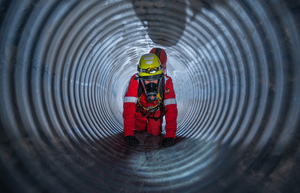

|
Edward Lowton
Editor |


|
Training essential for confined space working
04 May 2022
Every year a significant number of people are seriously injured or even killed whilst working in confined spaces across the UK, says Alan Murray

Accidents happen across a broad range of industries, including manufacturing, shipping, agriculture and marine. Dangers and challenges are present not only to those working within the confined space itself but also to any individuals attempting rescue if things go wrong. Despite rigorous health and safety measures and legislation, confined space working poses a high risk for workers and adequate training is essential.
How to prepare for confined space working
Once you have identified that work will be undertaken in a confined space it is important that the right controls are put in place. The Approved Code of Practice (ACoP) L1010 Safe Working in Confined Spaces provides details on the relevant provisions that must be considered. This includes an initial risk assessment that prioritises the identification of ‘measures needed so that work in confined spaces can be avoided’ .
An effective risk assessment should consider conditions and potential hazards in three general areas:
- The current condition of the work environment. Consider factors such as corrosion, areas that might be unstable, the previous contents and residues, contamination from other areas which can often be some distance away, any condition that may cause oxygen deficiency or enrichment and the physical layout of the area.
- Hazards and conditions created by the work in the confined space. This might include fumes or vapours from cleaning materials, the introduction of a source of ignition such as electrical equipment or work that increases the temperature.
- Hazards that are outside the space but can create a danger to people working in the area. Examples might include the unintended release of gases or liquids through pipe-work that is not adequately isolated, gases that drift in from adjacent plants and processes, or the unintended activation of any machinery in the confined space that isn’t adequately isolated.
If alternative external methods are not viable, then taking the necessary precautions for safe working in a confined space, which will include training, supervision, ensuring safe access and egress, testing and monitoring the atmosphere before and during the procedure, having a reliable communications system in place and suitable equipment for the job is essential. In the event of an accident, you would need to show you have followed the code or complied with the law in some other way otherwise a court will find you at fault.
What kind of training is needed?
The previously highlighted dangers and processes of confined space working demonstrate the essential nature of training for those managing or supervising confined space teams as well as those working in confined spaces and any potential rescue and recovery teams.
Options range from Confined Space Awareness training, through Low, Medium and High-Risk courses, plus Rescue Management and training covering the selection and maintenance of equipment involved in safe confined space working, such as gas monitors, breathing apparatus and personal protective equipment. If the risks are assessed to be too high or the job too complex for in-house teams, you should consider outsourcing jobs to confined space services experts.
The tragically high statistics regarding fatalities or serious injuries from working in confined spaces despite stringent health and safety legislation highlights the high-risk nature of this type of work. Managers and supervisors, workers and rescue crews all need a high standard of training and a robust practical understanding to effectively mitigate risks and prepare for any and all scenarios.
A well-trained team is prepared for all eventualities. That is the best step forward to reducing confined space working risks.
Alan Murray is CEO of the BSIF
For more information:
www.bsif.co.uk
- Submissions open for BSIF Safety Awards
- Clean air awareness campaign launches
- BSIF urges businesses to review PPE stock for the year ahead
- BSIF urges businesses to review PPE stock for the year ahead
- Luke Neale in the spotlight
- Busy summer ahead for the BSIF
- Shocking 79% of PPE from non-registered providers fails BSIF tests
- Impact of new health and safety sentencing guidelines
- Tailored protection: The push for PPE that fits every worker
- Effective communication increases productivity on high-noise sites
- No related articles listed


















